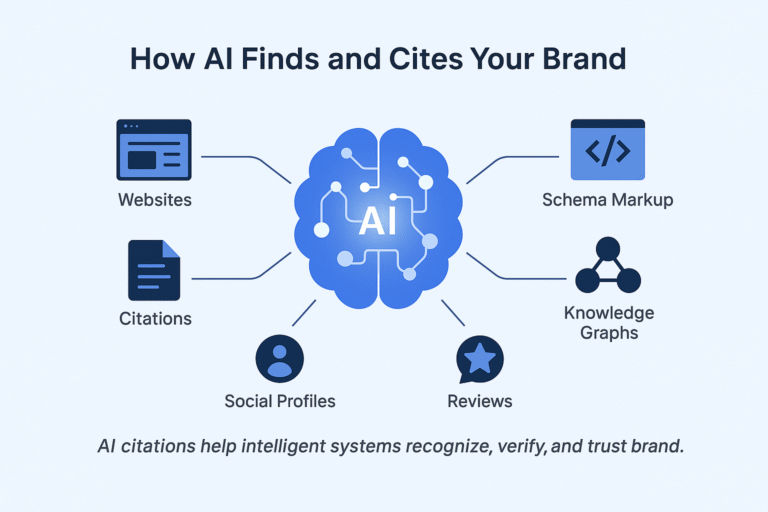AEO Mastery: Step-by-Step Guide to Building AI Citations & Boosting Visibility
Blogs | Category
Written By: Lauren Davison
Introduction
The internet changes faster than ever. What people see online is not just chosen by search engines anymore. Today, smart systems, powered by AI, decide what gets noticed, trusted, and shared. That shift has reshaped how visibility works.
Welcome to the world of Answer Engine Optimisation (AEO), where your content earns attention by proving its credibility to intelligent tools that think and learn.
This AEO guide to building AI citations & boosting visibility is your roadmap to staying visible in that new landscape. You’ll learn how to create strong digital citations that AI systems can read, value, and recommend.
Everything is explained in detail. Just clear, useful steps that help your brand shine where it matters most: inside the answers that AI delivers every day.
Table of Contents
Why AEO (Answer Engine Optimisation) Matters Now
Answer Engine Optimisation (AEO) is the process of making your brand easy for AI systems and answer engines to find, understand, and mention when sharing information online.
Search behaviour has changed. People no longer rely only on search engines. They ask questions through AI chats, voice assistants, and smart search tools that pull answers directly from verified data.
These systems depend on trusted citations, structured details, and knowledge graphs to decide which brands to feature.
If your brand is missing from those data sources, it simply won’t appear. You lose visibility, clicks, and trust. AEO helps fix that. It builds the kind of online signals that AI looks for: clear facts, accurate context, and strong digital references.
When done right, it helps your brand show up inside the answers people see, not just in a list of links.

What Are AI Citations & How AI Uses Them
Definition of AI Citations
AI citations are the digital proof points that help smart systems confirm facts and connect them to trustworthy sources. They include everything from website pages and schema data to business listings, reviews, and knowledge graph entries.
Think of them as the online trail that shows your brand is genuine. When your details match across multiple platforms, AI can clearly identify who you are and what you do. That consistency builds trust.
These linked references form what’s known as branded citations for AI markers, which tie your brand to verified, factual information across the web.
Where AI Sources Citation Data From
- Structured data (schema): Gives AI clean facts about your business.
- Trusted websites: Add authority and help confirm accuracy.
- Knowledge graphs: Connect your brand to topics, people, and entities.
- FAQs: Provide direct answers that AI can easily use.
- Customer reviews: Reflect quality and real-world trust.
- Syndicated data: Keeps your brand information accurate everywhere.
The AEO Playbook — Step-by-Step Actions
Building visibility in AI search is not random luck. It is a clear process. This AEO guide to building AI citations and boosting visibility breaks down each step to help your brand earn trust and recognition across intelligent platforms.
1. Audit Your Current Knowledge Signals
Start by reviewing how your brand appears online. Review your knowledge panel, Google Business Profile, and, if relevant, Wikipedia or Wikidata pages. These entries shape how AI understands your entity. Check your schema implementation and see if it matches what appears in search.
Use tools like Google Search Console, Knowledge Graph lookups, and schema validators to find gaps or errors. This step ensures AI systems have a clean, accurate foundation to read from.
2. Implement & Standardize Structured Data
Structured data is the backbone of schema markup for brands. Add LocalBusiness, Organisation, or Product schema depending on your niche. Include your logo, contact details, social links, and FAQ data in JSON-LD format.
Be consistent across all pages. Use “sameAs” links to connect your brand’s web presence. Correctly structured data tells AI what’s official and what to trust.
3. Claim & Optimise Your Knowledge Profiles
Claim every profile that represents your brand. Start with Google Business Profile, Wikidata, LinkedIn, Crunchbase, and relevant industry directories. Ensure your name, address, and descriptions match exactly.
These platforms feed directly into knowledge graphs. A consistent presence across them improves how AI systems connect your entity to accurate facts.
4. Create Authoritative, Citation-Ready Content
AI needs credible content to quote. Publish articles, research pages, guides, and case studies that include clear facts and timestamps. Use short, structured sections that make it easy for AI to extract answers.
Focus on original insights or data-backed findings. The stronger your content authority, the more likely AI is to feature and cite it.
5. Build High-Quality External Citations
Expand your reach with branded citations for AI on respected websites. Get listed or mentioned on educational domains, government sites, and reputable media outlets.
Use PR outreach, guest posts, and data reports to attract natural mentions. Each citation boosts trust and signals that your brand belongs in verified AI outputs.
6. Structure Content for Conversational Queries
AI tools interpret questions in natural language. Optimise your pages with conversational Q&A, short responses, and structured FAQ schema.
Design your answers to sound like how people talk to AI assistants. This structure helps AI pull accurate, ready-to-serve responses while improving your schema markup for brand visibility.
7. Monitor, Verify & Correct AI Mentions
AI-generated results can shift quickly. Search your brand regularly within ChatGPT, Google’s AI Overview, and other assistants. See how your business is described.
If you find errors, update your primary sources and request corrections on Wikidata or similar platforms. Keeping your information clean helps AI stay aligned with your verified data.
Measuring AEO Success
A strong AEO plan only works when it shows clear results. Measuring performance helps you see what’s effective and where to improve. Success in Answer Engine Optimisation is not just about keyword rankings. It depends on how AI systems find, cite, and recommend your brand to users.
Key Metrics to Track
Start by watching changes in branded AI citations. Check how often your brand appears in AI answers or summaries. Look for mentions in structured results or knowledge panels.
Next, review visibility inside AI-generated snippets on ChatGPT, Google AI Overview, or Bing Copilot. Track whether users are asking AI about your brand directly. This rise in branded conversational queries shows growing trust.
Finally, monitor traffic from AI surfaces. Growth here reveals how well you optimise for AI search beyond normal SEO methods.
These signals together show how AI reads, values, and ranks your business.
Tools & Processes
Use SERP tracking tools like Ahrefs or Semrush to track AI-enhanced visibility. Set up mention alerts with Brand24 or Talkwalker. Run AI query checks in ChatGPT, Gemini, or Copilot to see what details they share. Review your schema and Wikidata profiles often.
AEO success reflects how strongly your brand communicates credibility, not just how high it ranks.
Common Pitfalls & How to Avoid Them
Even a strong AEO plan can fail if the basics are ignored. Avoiding these mistakes keeps your signals clear and accurate.
Inconsistent Brand Data
AI values consistency. If your business name, address, or phone number differ across profiles, it creates confusion. Keep every listing identical, from Google Business Profile to Wikidata. Use the same brand description, tone, and contact details everywhere.
Relying Only on Links
Links still help, but they are not enough. AI focuses on structured data, verified profiles, and mentions from trusted sources. Add schema markup, maintain accurate citations, and link your brand across all knowledge networks.
Ignoring Attribution
AI engines look for credibility. Always include author names, publication dates, and organisation details on your pages.
Clear attribution tells AI where information comes from and helps it verify accuracy. Brands that show provenance get cited more often and appear in higher-quality AI results.
Future-Proofing Your Brand for AI Search
AI search keeps evolving. To stay visible, your brand must grow with it. Consistent upkeep builds trust and ensures your data is accurate across platforms.
- Audit regularly: Check your profiles, schema, and citations every few months. Fix anything outdated or unclear.
- Keep data fresh: Update structured details, products, and contact info as your business changes.
- Watch how AI describes you: Test AI tools often. Correct wrong facts or missing details fast.
- Create original insights: Publish new research or useful data so AI sees your brand as a trusted source.
- Assign clear roles: Have someone responsible for keeping your information correct.
Small, steady updates help your brand stay reliable in the fast-moving world of AI discovery.
Conclusion – Be the Source AI Trusts
If you want AI to show your brand first, earn its trust. Keep your data accurate and easy to read. Use structured content that confirms your authority. Build strong citations and publish honest, useful information.
Each update strengthens your credibility. Treat these signals as core parts of SEO, not extras. At Midland Marketing, we help brands grow reliable footprints that AI understands and values. Be the source AI turns to when it needs the right answer.
Frequently Asked Questions
- What is AEO?
AEO, or Answer Engine Optimisation, helps AI find and trust your brand by improving how information is structured and verified online.
- Why do AI citations matter?
AI citations prove your brand is real and credible. They help AI tools confirm facts and choose your business in the results.
- How does schema markup for brands help?
It gives AI clean data about your business, like name, contact, and links, improving accuracy.
- How often should I update my AEO data?
Review profiles and schema every quarter to keep details fresh and consistent.
- How can Midland Marketing help?
Midland Marketing builds strong AI citations, structured data, and authority signals so your brand earns trust and stands out in AI-driven search.

Written by - Lauren Davison
Introducing Lauren – one of our content writers who has a flair for SEO and creative strategy!
With a Master’s Degree in Creative Writing, Lauren has niched down into SEO and content writing.
Outside of work, she loves watching the darts, reading and the pub on the weekend.
Want some more?
Latest Insights & News

AEO Mastery: Step-by-Step Guide to Building AI Citations & Boosting Visibility
When targeting the keyword “AEO Guide to Building AI Citations & Boosting Visibility,” focus on Authoritative Engine Optimization (AEO) principles. AI-driven search requires clear, structured, and entity-rich content.

Pillar Pages: The Secret to Skyrocketing Your SEO Rankings in 2025
Using pillar pages for SEO rankings is one of the most effective strategies in 2025. A pillar page acts as a central hub that covers a broad topic in depth and links to more detailed cluster articles. This structure helps search engines understand your content hierarchy, improves crawlability, and strengthens topical authority.

Mastering Multi-Location SEO: The Smart Way to Grow Local Visibility at Scale
When targeting “multi-location SEO,” focus on building a strong, consistent local presence for every branch of your business. Create and optimize individual location pages with unique content, accurate NAP details, and localized keywords. Ensure each location has an updated Google Business Profile, gather local reviews, and implement location-based schema markup. Multi-location SEO works best when you maintain consistency across all platforms while tailoring content to each area’s audience. This structured approach helps you scale local visibility, improve map rankings, and build stronger trust with customers searching in different regions.
